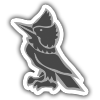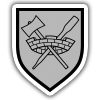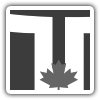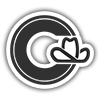Northwest Territories, Canada
Flag
The flag of the Northwest Territories was adopted by the territorial council in 1969. The blue vertical stripes represent the lakes and waters of the territory and the white represents snow and ice. The shield of the territorial coat of arms is featured in the center of the flag. The white symbolizes the polar icepack, the blue wavy stripe the northwest passage, the green the forested area and the red the tundra. The head of an arctic fox represents the local fauna and the yellow rectangles symbolize mineral riches.
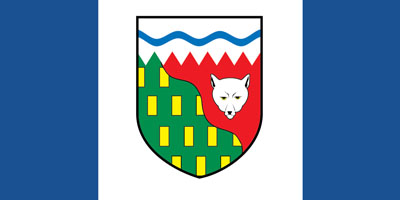
Other Provincial Symbols
- Floral Emblem: Mountain Avens
- Tartan: Tartan of the Northwest Territories
- Tree: Tamarack
- Bird: Gyrfalcon
- Fish: Arctic Grayling
- Mineral: Native Gold
- Gemstone: Diamond
Coat of Arms
The Northwest Territories' coat of arms was granted by Queen Elizabeth II in 1956 and represents the geography of the Northwest Territories at that time. The white upper third of the shield represents the polar icepack and is crossed by a wavy blue line that symbolizes the Northwest Passage. The lower portion is divided diagonally by a wavy line that represents the treeline; the green stands for the forested areas south of the treeline, and the red represents the tundra to the north.
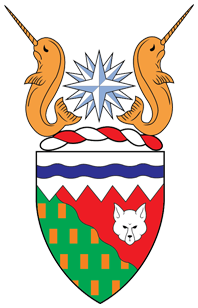
Minerals and fur, the foundation of northern wealth, are represented by gold billets in the green section of the shield and the face of a white fox in the red section. The crest includes two narwhals, and the compass rose between them represents the North Magnetic Pole.

Origin of the Name
Most of the Northwest Territories was known as the North-Western Territory until 1870. Then as now, the name is primarily descriptive of the location of the Territories.

History
The Northwest Territories were inhabited by Inuit and First Nations peoples long before the Europeans arrived in search of the elusive Northwest Passage. Native Inuit included the Mackenzie, Copper, Caribou and Central nations. There were also many nations when the Europeans first arrived, among them the Yellow-Knife, Chipewyan, Sekani, Beaver, Nahanni, Dogrib and Slavey. Some nations in the area spoke a form of the Athapaskan language, the only native language in North America to have traces of an Asiatic origin.
The first European explorers were the Vikings, who sailed to the Eastern Arctic about 1000 AD. However, Martin Frobisher's expeditions in the 1570s were the first recorded visits to the Northwest Territories by an explorer. In 1610, Henry Hudson, while looking for the Northwest Passage, landed briefly on the western shore of the bay that bears his name. His discovery opened the interior of the continent to further exploration.
By the 1700s, the Northwest Territories were dominated by two fur-trading companies: the Hudson's Bay Company, based in London, England, and the North West Company based in Montréal.
In 1870, the British government transferred control of the North-Western Territory to Canada, and the Hudson's Bay Company sold Rupert's Land to the new Dominion for 300,000 pounds sterling. The combined area was renamed the Northwest Territories. Ten years later the British government transferred the islands of the Arctic archipelago to these territories.
At some time in their history, the Northwest Territories have included all of Alberta, Saskatchewan, Yukon, and most of Manitoba, Ontario and Quebec.
In 1870, the original tiny province of Manitoba was carved out of the area. In 1905, both Alberta and Saskatchewan were created from the Territories. Manitoba was increased in size in 1881 by taking land from the Territories. In 1898, Yukon became a separate territory, while the provinces of Manitoba, Ontario and Quebec were enlarged by taking land from the Territories in 1912. Even with this loss of land, the Northwest Territories remained Canada's largest political subdivision (with just over a third of the country's total area) until 1999.
In April 1999, the Northwest Territories was divided in two, with 60 percent of the land being transferred to the new territory of Nunavut in Canada's Eastern Arctic.
Civic Flags
Yellowknife, Northwest Territories
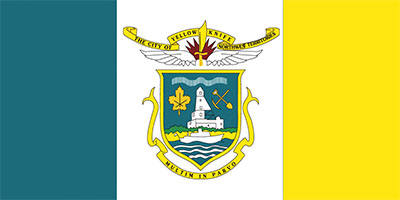

Franco-Tenois Flag







































